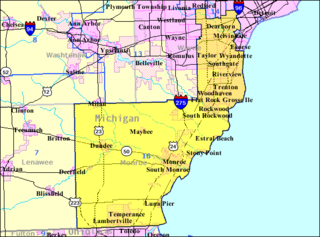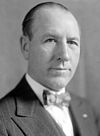The 20th congressional district of Ohio was created after the 1840 census. It was eliminated in the redistricting following the 1990 census, and redistricted and renumbered as the 10th district.
The 21st congressional district of Ohio was a congressional district in the state of Ohio. It was eliminated in the redistricting following the 1990 census.
The 23rd congressional district of Ohio was eliminated as a result of the redistricting cycle after the 1980 Census. The district had been created after the elimination of Ohio's at-large congressional district after the 1950 election.
North Dakota's 1st congressional district is an obsolete congressional district in the state of North Dakota that existed from 1913 to 1933, and from 1963 to 1973.
Kentucky's 7th congressional district was a district of the United States House of Representatives in Kentucky.
South Dakota's 3rd congressional district is an obsolete United States congressional district. It was created after the 1910 census and abolished after the 1930 census. The district covered all of the counties in South Dakota west of the Missouri River.
South Dakota's 2nd congressional district is an obsolete district. It was created after the 1910 census and was eliminated as a result of the redistricting cycle after the 1980 Census. Members were elected at-large until the formation of individual districts after the 1910 census. From 1913 until 1933, the 2nd district covered much of northeastern South Dakota, including the cities of Aberdeen, Brookings, Huron, and Watertown. When South Dakota's 3rd congressional district was eliminated after the 1930 census, the 2nd district was relocated to cover all of the counties in South Dakota west of the Missouri River. Population changes eventually moved the district's boundaries further east. During the 97th Congress, it covered all but the 21 easternmost counties in the state.
The 13th congressional district of Ohio is represented by Representative Emilia Sykes. Due to reapportionment following the 2010 United States Census, Ohio lost its 17th and 18th congressional districts, necessitating redrawing of district lines. Following the 2012 elections, the 13th district changed to take in much of the territory in the former 17th district, including the city of Youngstown and areas east of Akron.

The 16th congressional district of Ohio is an obsolete United States congressional district last represented by Representative Anthony Gonzalez (R). It was last located in the northeast of the state, covering Wayne County and with arms extending north into the suburbs of Cleveland, and east into Greater Akron and Stark County. The district was eliminated upon the swearing in of the 118th United States Congress on January 3, 2023, as the reapportionment after the 2020 census reduced the number of congressional districts in Ohio to fifteen.
South Dakota's 1st congressional district is an obsolete congressional district that existed from 1913 to 1983.
Pennsylvania's 35th congressional district was one of Pennsylvania's districts of the United States House of Representatives.
Michigan's 9th congressional district is a United States congressional district located in The Thumb and northern portions of Metro Detroit of the State of Michigan. Counties either wholly or partially located within the district include: Huron, Tuscola, Sanilac, Lapeer, St. Clair, Macomb and Oakland. With a Cook Partisan Voting Index rating of R+18, it is the most Republican district in Michigan.
Pennsylvania's 36th congressional district was one of Pennsylvania's districts of the United States House of Representatives.
Pennsylvania's 29th congressional district was one of Pennsylvania's districts of the United States House of Representatives.
Pennsylvania's 28th congressional district was one of Pennsylvania's districts of the United States House of Representatives.

Michigan's 16th congressional district is an obsolete United States congressional district in Michigan. It covered the communities of Dearborn, Downriver and Monroe County.
Alabama's 9th congressional district was formerly apportioned to portions of central and western Alabama from 1893 until 1963 when the seat was lost due to reapportionment after the 1960 United States Census.
North Dakota's 2nd congressional district is an obsolete congressional district in the state of North Dakota that was created by reapportionments in 1913, and eliminated by the reapportionments in 1933. North Dakota elected its two Representatives in a two-member at large district from 1932 to 1960, but then resurrected single-member districts in 1962. The district was eliminated by the reapportionment as a result of the 1970 redistricting cycle after the 1970 United States census. The seat was last filled from 1971 to 1973 by Arthur A. Link, who sought the office of Governor of North Dakota after not being able to run again for the defunct seat.
Pennsylvania's 22nd congressional district was one of Pennsylvania's districts of the United States House of Representatives.



